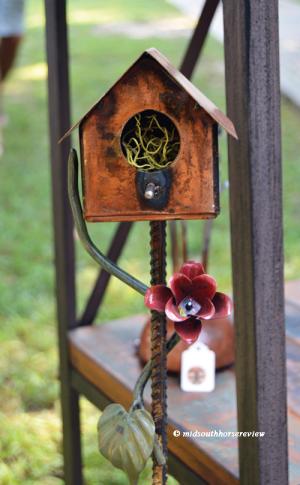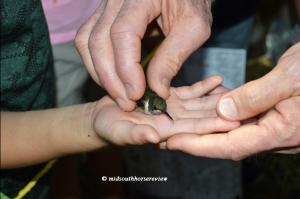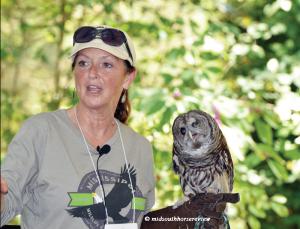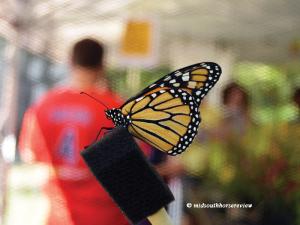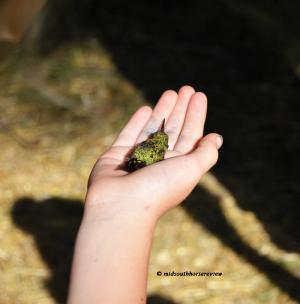Article & photos by Nancy Brannon
On September 6-7, 2019 Strawberry Plains Audubon Center (SPAC), Holly Springs, Mississippi, hosted the 20th anniversary Hummingbird Migration and Nature Celebration. This year nearly 200 volunteers were on hand to educate the visitors about Hummingbirds, butterflies, and nature, and make the event move smoothly.
Hummingbirds were, of course, the main attraction, with two banding stations where the birds could be seen up close, and the back porch of the Davis House, where visitors could watch all the Hummingbird action at the feeders. Southern Avian Research staff members were on hand to handle the delicate little creatures and to explain all about them to the visitors, as they examined, measured, weighed, and banded Hummingbirds. Folks got to feel their fast heart beat, and some got to hold one in their hand when the bird was ready to be released.
The second most popular exhibit was the butterflies exhibit. Dr. Holley Muraco demonstrated the full cycle of the Monarch butterfly, from laying their eggs on milkweek plants to developing into the caterpillar and pupae stage. The pupae hung from earring wires in a display case and, some of the lucky visitors could actually see them emerge from the pupae into beautiful, newborn Monarch butterflies! The newborns were given a few hours to get stronger, and then moved to a large tent in which folks could watch them up close and personal on a piece of sponge (dipped in Gatorade) at the end of a stick. When they were ready, the Monarchs took flight.
For nature education, there were a number of expert presenters in three areas: the Special Programs Tent, Wildlife Wonders Tent, and the Ecology Tent. Here’s a sampling of what folks could learn.
Brian “Fox” Ellis told riveting tales of Adventures with Audubon, as he portrayed John James Audubon.
Author Doug Tallamy, Ph.D. (University of Delaware) was back this year with “A Guide to Restoring the Little Things that Run the World.” Tallamy explained to the audience that insect populations have declined 45% globally since 1974. The most alarming part of this statistic is that we don’t seem to care, despite the fact that a world without insects is a world without humans! So how do we build beautiful landscapes that support the pollinators, herbivores, predators, and parasitoids that run the ecosystems we depend on? Tallamy explained the many essential roles insects play, and described the simple changes that people can make in their landscapes, and our attitudes, to keep insects alive and well. Saving our native insects should start at home in our own and our neighbor’s yards. Growing plants native to your location is the key because they support the most native insects (and birds).
Nine things that you can do:
(1) Cut your lawn in half (and plant native plants that attract pollinators in the other half)
(2) Avoid senseless mowing (let it grow!)
(3) Remove invasive species from your property
(4) Use keystone plants; “keystone” plant groups (genera) host the most caterpillars. Build a landscape layered with plants.
(5) Preserve your leaf litter and ground covers
(6) Put motion sensors on your security lights
(7) Oppose mosquito spraying. Mosquito spraying uses broad spectrum insecticides that can kill or weaken anything flying at the time of application. The best way to deal with mosquitoes is to eliminate their breeding sources in yours and neighbors’ yards.
(8) Minimize insecticide use
(9) Join your Homeowners Association (HOA) and change from within. If your house is in an area controlled by an HOA, their rules can be a significant barrier to having control over what you plant in your yard.
Tallamy also presented “A Chickadee’s Guide to Gardening,” and is author of the book Bringing Nature Home. Find more information at: http://www.bringingnaturehome.net/ and at New Hope Audubon: https://www.newhopeaudubon.org/blog/saving-the-birds-one-yard-at-a-time/
Kate Friedman and her team at the Mississippi Wildlife Rehabilitation (MWR) brought several raptors, including Rufus, the resident Eastern Screech Owl, a Barred Owl, and other wildlife, with fascinating stories of rescue and release of wildlife and the people who find them. She told the story of “Lisa Marie,” the box turtle who was hit by a car, and brought to MWR, where she had surgery to repair her shell. Fortunately she had no internal injuries, but all of her shell could not be repaired. Over time, it grew back, but in a leathery condition. MWR staff emphasized NOT to relocate turtles. If they are crossing a road, help them get across in the direction they are going, and then leave them on the other side of the road. Kate said a turtle will literally kill itself trying to get back to its home if it’s relocated. Another staff member asked: Why did the turtle cross the road? To get to the Shell Station, of course!
Favorite presenter Terry Vandeventer was back with his Good Ole, Down-Home Mississippi Snakes. Terry brings a variety of species and explains their physical characteristics, natural history, myths, and benefits to humans and public health. He always tries to instill positive attitudes toward snakes with factual information that he provides in a humorous and exciting manner. He emphasizes the importance of conservation of snakes and respect for all wildlife.
About the black racer: Have you heard wild stories about black racers chasing people across a field? Have you been told to chase a black racer to keep it from chasing you? The truth is that they are fairly fast moving snakes. They use their speed to escape from threatening situations and are also good swimmers and climbers. They can move at a top speed of 4 miles per hour, about the speed of a human walking quickly. But black racers are considered an endangered species, mainly because their habitat is being destroyed by human activities.
The speckled king snake is a non-venomous constrictor. The thing that makes king snakes popular is their immunity to the venom of the pit vipers found in the U. S. A speckled king snake can kill and eat rattlesnakes, copperheads, and water moccasins without any fear of their venom. Terry demonstrated how a speckled king snake can kill a copperhead snake. It uses its constricting ability to wrap around the copperhead and squeeze it to death before it devours it.
Find more information at: http://livingreptilemuseum.com/home/
Bob Tarter, with Animalogy, brought some exotic animals for his Circle of Life presentation, such as an albino Burmese Python.
Julia Clarke, Ph.D. (University of Texas) presented “Song, Color, Feathers, Flight: A Dinosaurian History of Birds.”
Kara Lankford, National Audubon Society, talked about Restoring the Gulf of Mexico for Birds and People.
Sharon Peterson told folks about Incredible Bats, our conservation allies.
There were plenty of vendors, selling jewelry, natural soaps, carved wood products, local honey, books, T-shirts, a variety of crafts, and, of course, all kinds of Hummingbird support items, particularly feeders from Wild Birds Unlimited.
There was so much to see and learn at SPAC this weekend that there isn’t sufficient room to convey it all here. I met many people there who are truly Hummingbird enthusiasts, maintaining 6-8 or more feeders, and delighting in their bird observations. The wildlife plant sale was quite successful, as folks were eager to put in their yards plants that will attract and support birds, insects, and butterflies.
Find more information about this and other events at SPAC at: strawberry.audubon.org.
On September 6-7, 2019 Strawberry Plains Audubon Center (SPAC), Holly Springs, Mississippi, hosted the 20th anniversary Hummingbird Migration and Nature Celebration. This year nearly 200 volunteers were on hand to educate the visitors about Hummingbirds, butterflies, and nature, and make the event move smoothly.
Hummingbirds were, of course, the main attraction, with two banding stations where the birds could be seen up close, and the back porch of the Davis House, where visitors could watch all the Hummingbird action at the feeders. Southern Avian Research staff members were on hand to handle the delicate little creatures and to explain all about them to the visitors, as they examined, measured, weighed, and banded Hummingbirds. Folks got to feel their fast heart beat, and some got to hold one in their hand when the bird was ready to be released.
The second most popular exhibit was the butterflies exhibit. Dr. Holley Muraco demonstrated the full cycle of the Monarch butterfly, from laying their eggs on milkweek plants to developing into the caterpillar and pupae stage. The pupae hung from earring wires in a display case and, some of the lucky visitors could actually see them emerge from the pupae into beautiful, newborn Monarch butterflies! The newborns were given a few hours to get stronger, and then moved to a large tent in which folks could watch them up close and personal on a piece of sponge (dipped in Gatorade) at the end of a stick. When they were ready, the Monarchs took flight.
For nature education, there were a number of expert presenters in three areas: the Special Programs Tent, Wildlife Wonders Tent, and the Ecology Tent. Here’s a sampling of what folks could learn.
Brian “Fox” Ellis told riveting tales of Adventures with Audubon, as he portrayed John James Audubon.
Author Doug Tallamy, Ph.D. (University of Delaware) was back this year with “A Guide to Restoring the Little Things that Run the World.” Tallamy explained to the audience that insect populations have declined 45% globally since 1974. The most alarming part of this statistic is that we don’t seem to care, despite the fact that a world without insects is a world without humans! So how do we build beautiful landscapes that support the pollinators, herbivores, predators, and parasitoids that run the ecosystems we depend on? Tallamy explained the many essential roles insects play, and described the simple changes that people can make in their landscapes, and our attitudes, to keep insects alive and well. Saving our native insects should start at home in our own and our neighbor’s yards. Growing plants native to your location is the key because they support the most native insects (and birds).
Nine things that you can do:
(1) Cut your lawn in half (and plant native plants that attract pollinators in the other half)
(2) Avoid senseless mowing (let it grow!)
(3) Remove invasive species from your property
(4) Use keystone plants; “keystone” plant groups (genera) host the most caterpillars. Build a landscape layered with plants.
(5) Preserve your leaf litter and ground covers
(6) Put motion sensors on your security lights
(7) Oppose mosquito spraying. Mosquito spraying uses broad spectrum insecticides that can kill or weaken anything flying at the time of application. The best way to deal with mosquitoes is to eliminate their breeding sources in yours and neighbors’ yards.
(8) Minimize insecticide use
(9) Join your Homeowners Association (HOA) and change from within. If your house is in an area controlled by an HOA, their rules can be a significant barrier to having control over what you plant in your yard.
Tallamy also presented “A Chickadee’s Guide to Gardening,” and is author of the book Bringing Nature Home. Find more information at: http://www.bringingnaturehome.net/ and at New Hope Audubon: https://www.newhopeaudubon.org/blog/saving-the-birds-one-yard-at-a-time/
Kate Friedman and her team at the Mississippi Wildlife Rehabilitation (MWR) brought several raptors, including Rufus, the resident Eastern Screech Owl, a Barred Owl, and other wildlife, with fascinating stories of rescue and release of wildlife and the people who find them. She told the story of “Lisa Marie,” the box turtle who was hit by a car, and brought to MWR, where she had surgery to repair her shell. Fortunately she had no internal injuries, but all of her shell could not be repaired. Over time, it grew back, but in a leathery condition. MWR staff emphasized NOT to relocate turtles. If they are crossing a road, help them get across in the direction they are going, and then leave them on the other side of the road. Kate said a turtle will literally kill itself trying to get back to its home if it’s relocated. Another staff member asked: Why did the turtle cross the road? To get to the Shell Station, of course!
Favorite presenter Terry Vandeventer was back with his Good Ole, Down-Home Mississippi Snakes. Terry brings a variety of species and explains their physical characteristics, natural history, myths, and benefits to humans and public health. He always tries to instill positive attitudes toward snakes with factual information that he provides in a humorous and exciting manner. He emphasizes the importance of conservation of snakes and respect for all wildlife.
About the black racer: Have you heard wild stories about black racers chasing people across a field? Have you been told to chase a black racer to keep it from chasing you? The truth is that they are fairly fast moving snakes. They use their speed to escape from threatening situations and are also good swimmers and climbers. They can move at a top speed of 4 miles per hour, about the speed of a human walking quickly. But black racers are considered an endangered species, mainly because their habitat is being destroyed by human activities.
The speckled king snake is a non-venomous constrictor. The thing that makes king snakes popular is their immunity to the venom of the pit vipers found in the U. S. A speckled king snake can kill and eat rattlesnakes, copperheads, and water moccasins without any fear of their venom. Terry demonstrated how a speckled king snake can kill a copperhead snake. It uses its constricting ability to wrap around the copperhead and squeeze it to death before it devours it.
Find more information at: http://livingreptilemuseum.com/home/
Bob Tarter, with Animalogy, brought some exotic animals for his Circle of Life presentation, such as an albino Burmese Python.
Julia Clarke, Ph.D. (University of Texas) presented “Song, Color, Feathers, Flight: A Dinosaurian History of Birds.”
Kara Lankford, National Audubon Society, talked about Restoring the Gulf of Mexico for Birds and People.
Sharon Peterson told folks about Incredible Bats, our conservation allies.
There were plenty of vendors, selling jewelry, natural soaps, carved wood products, local honey, books, T-shirts, a variety of crafts, and, of course, all kinds of Hummingbird support items, particularly feeders from Wild Birds Unlimited.
There was so much to see and learn at SPAC this weekend that there isn’t sufficient room to convey it all here. I met many people there who are truly Hummingbird enthusiasts, maintaining 6-8 or more feeders, and delighting in their bird observations. The wildlife plant sale was quite successful, as folks were eager to put in their yards plants that will attract and support birds, insects, and butterflies.
Find more information about this and other events at SPAC at: strawberry.audubon.org.
